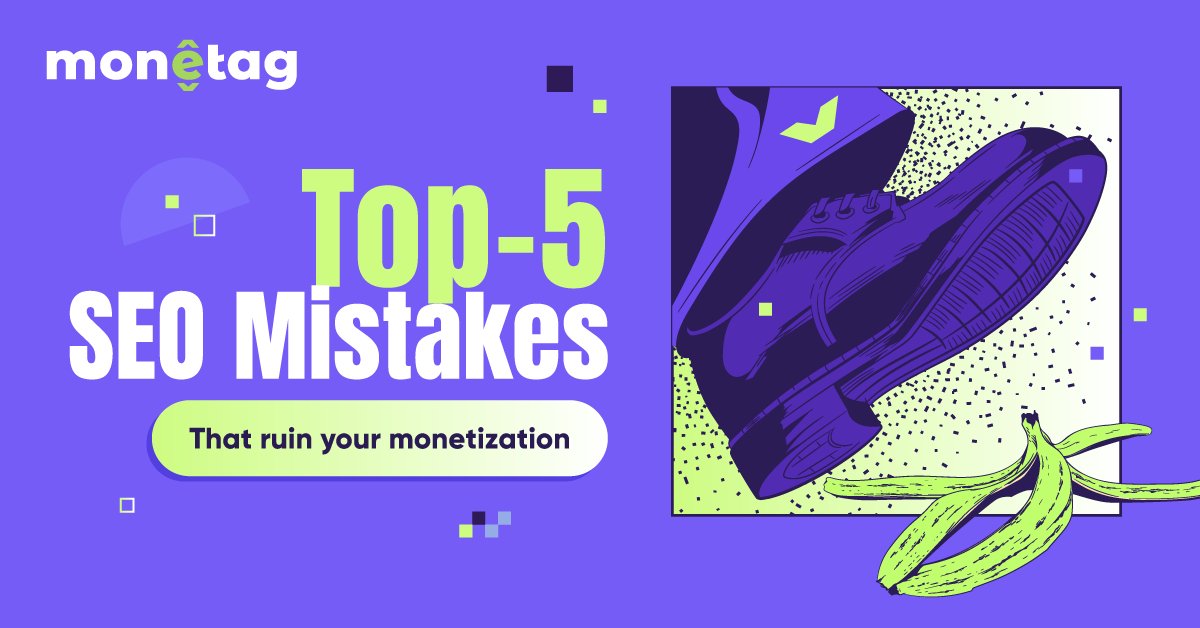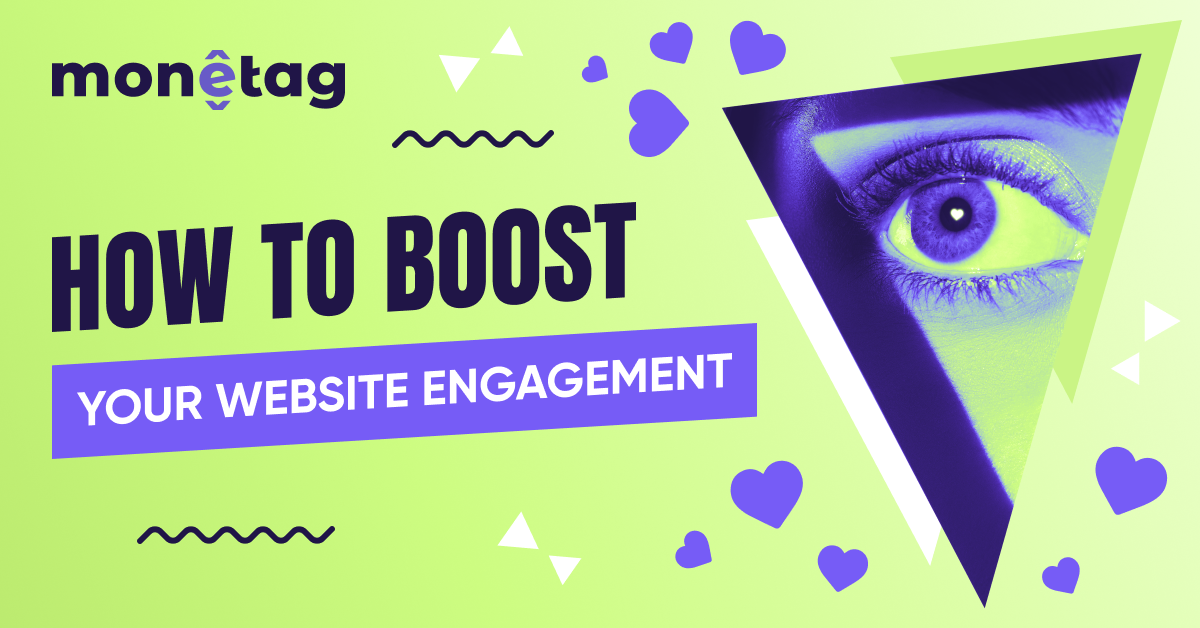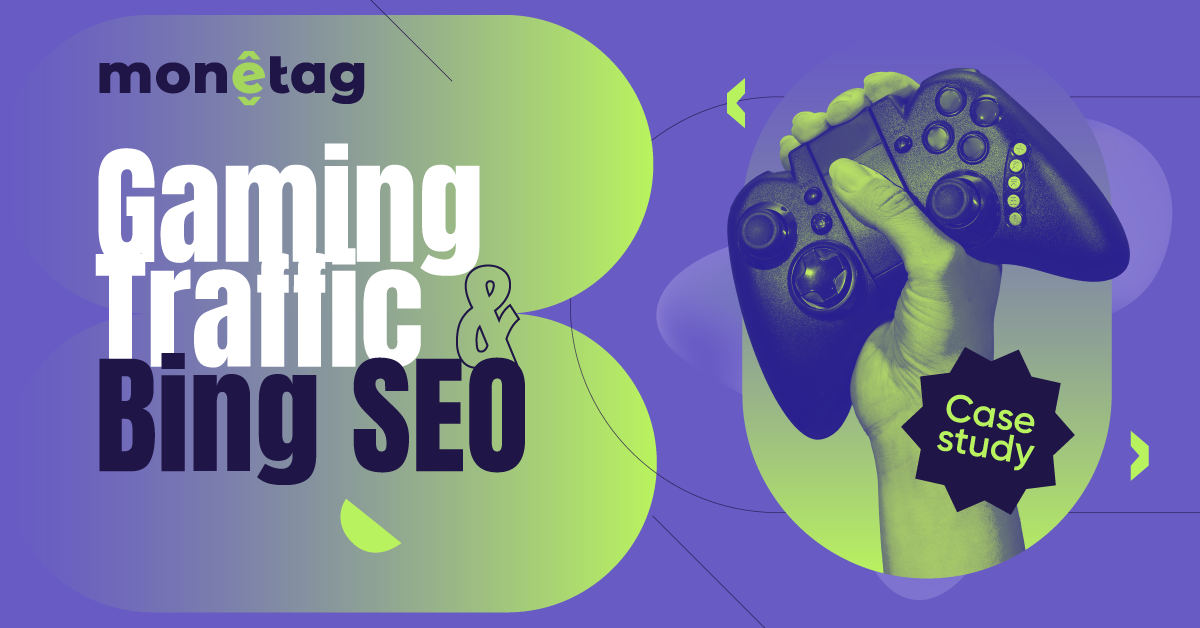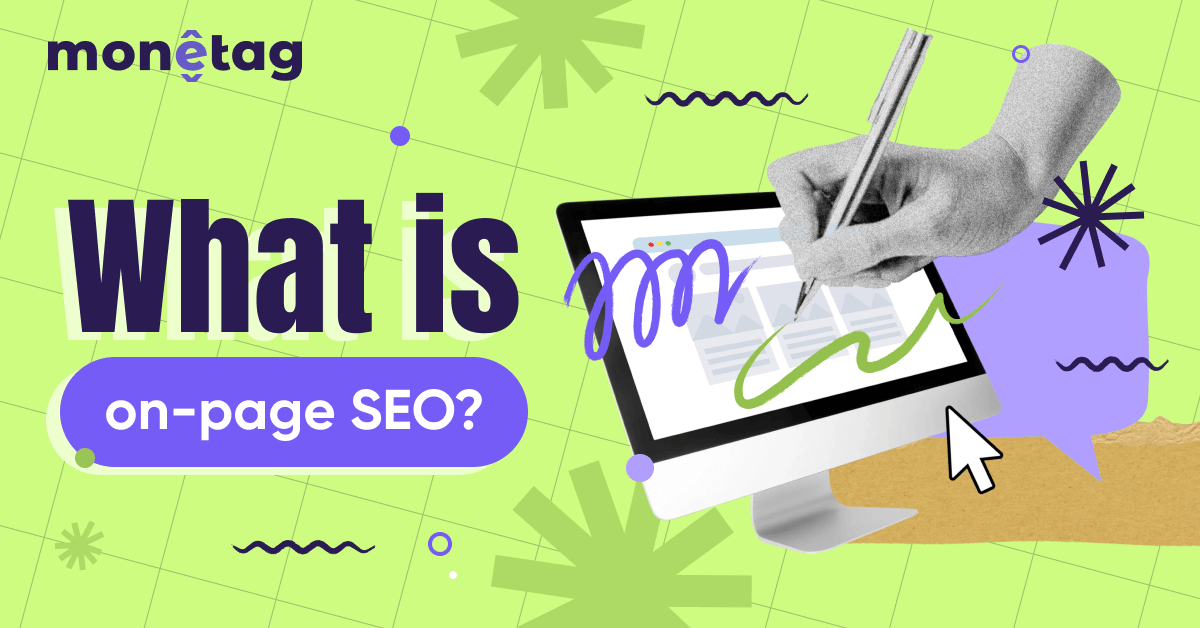Zero-Click Content: Does It Impact Your SEO and Monetization?
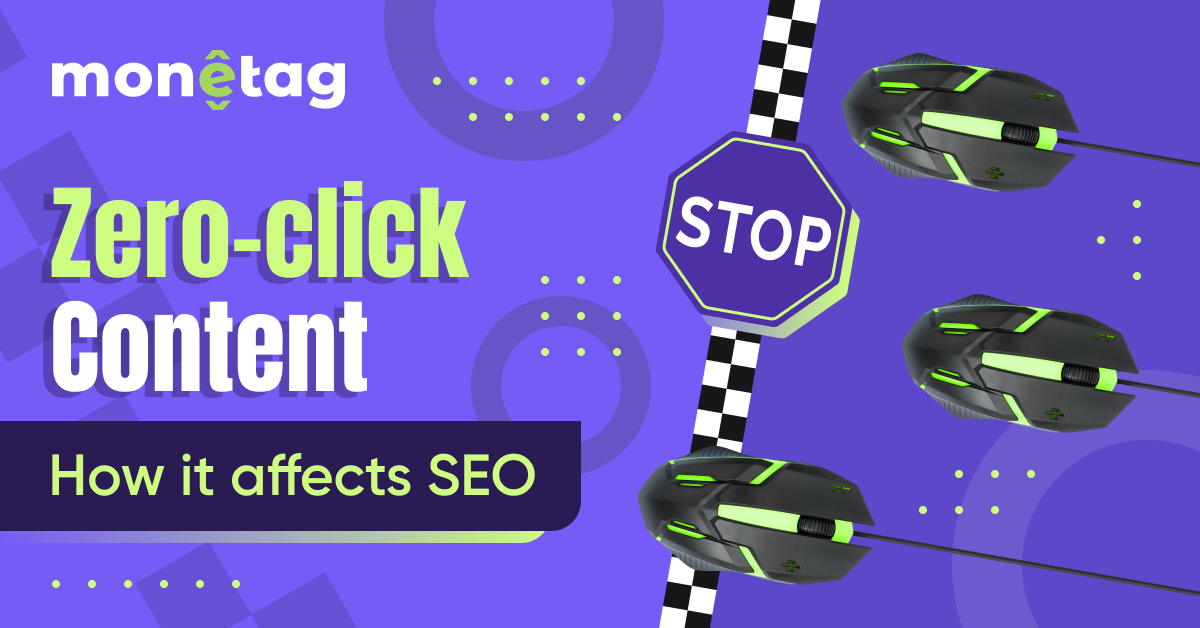
This post is also available in:
Pt
Es
I will begin by saying – times have changed in the world of digital marketing.
Nothing is like it used to be.
The number of clicks is not what counts the most anymore, or at least that seems to be the case.
Digital marketing experts are saying the audience has burned out from all the requests they have been asked to do while consuming content.
Fewer and fewer people want to click on a link in order to get the rest of the content somewhere else. For most of them, it’s about getting the whole information right away, without making additional steps. And some are tired of getting only a portion of the content while being asked to proceed to another page with READ MORE captions luring them to click on it.
So suddenly, zero-click content became a thing.
If you haven’t heard about it yet, that’s fine, it wasn’t such a burning topic till now. BUT if you are a publisher and want to know how to stay relevant and well-positioned on Google’s SERP, or how to keep your SEO in place, be sure to read on.
Now, since the topic is controversial, and there are quite opposite opinions on how to move forward with SEO, we will highlight and analyze all the main concerns to help you fill in the gaps in your understanding of the issue, and develop the right strategy.
What is zero click content, and why is it important?
Essentially, zero-click content is content that doesn’t require your audience to do anything except digest high-value information. So no clicks, no requests, just you providing them with written or video material, asking for nothing in return.
Sounds weird, right? Especially if up until now you did everything that’s in your power to shape your content into one juicy clickbait.
The reality is that a lot of low-quality content has been released through the years, with one intent only – to make that click happen, one way or another.
As a result, the audience became irritated, impatient, and defensive, and it became extremely difficult to get them to click that CTA, as Amanda Natividad from SparkToro would say.
So now, we are going back to basics and trying to rebuild a trusted bond with a targeted market through zero-content. Providing the audience with the best materials with no strings attached.
We refer to blog posts and emails that are highly engaging and won’t lead their audience elsewhere via link, to Tweet, LinkedIn, or Facebook posts that are not serving partial info with teasers like “Fill out the form”, “ Request a demo”, or “Follow the link and learn more”.
Anyhow, social media is generally pro zero-click: Instagram won’t allow you to add a link to the caption, and most other platforms prefer linkless posts, encouraging its users to stay, rather than link out.
The hope is the audience will digest it, appreciate it, get back, and share your content with others, which will increase your reach and brand recognition.
Google’s twist: Zero click search
Now let’s see who’s to “blame” for this trend.
Apparently, for the last three years, a huge amount of Google’s searches have been zero click searches. It’s actually what’s happening with all search engines, but we will be focusing on Google, given it is the leading search engine in most parts of the world – it has an 85% market share.
Since Google launched the Knowledge graph in 2012, the amount of zero-click content it’s presenting on the first Search Engine Result Page (SERP) is becoming bigger and bigger.
Why?
Because Google wants its users to have answers to their queries right away, without delay. The main goal is to improve user experience, and they believe this is the way to do it.
Besides Knowledge graphs, you will notice Featured snippets, Knowledge panels, maps, calculators, PAA (People Also Ask), PASF (People Also Search For), lists, and some other Google features, all before organic search results.
This is what we refer to:
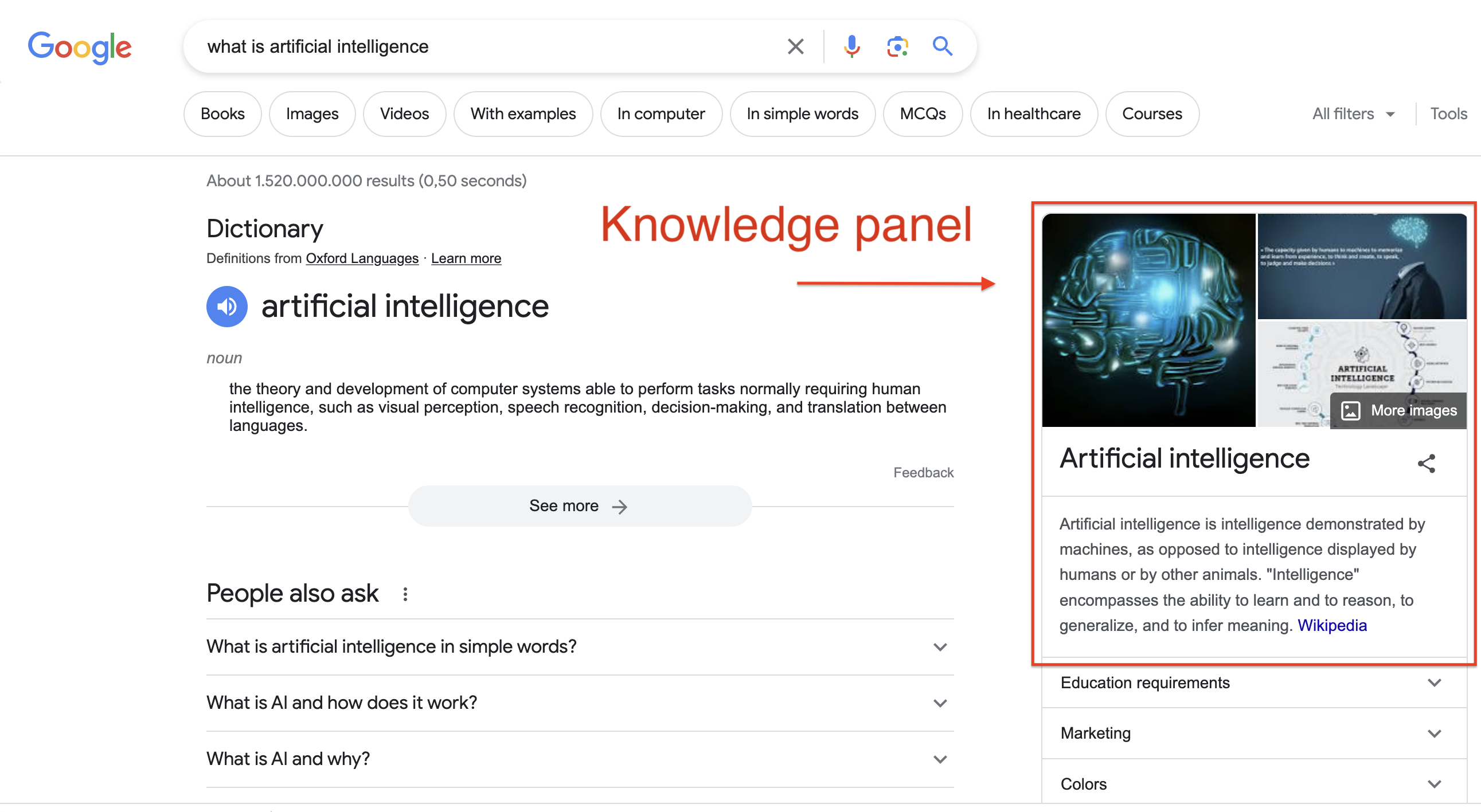
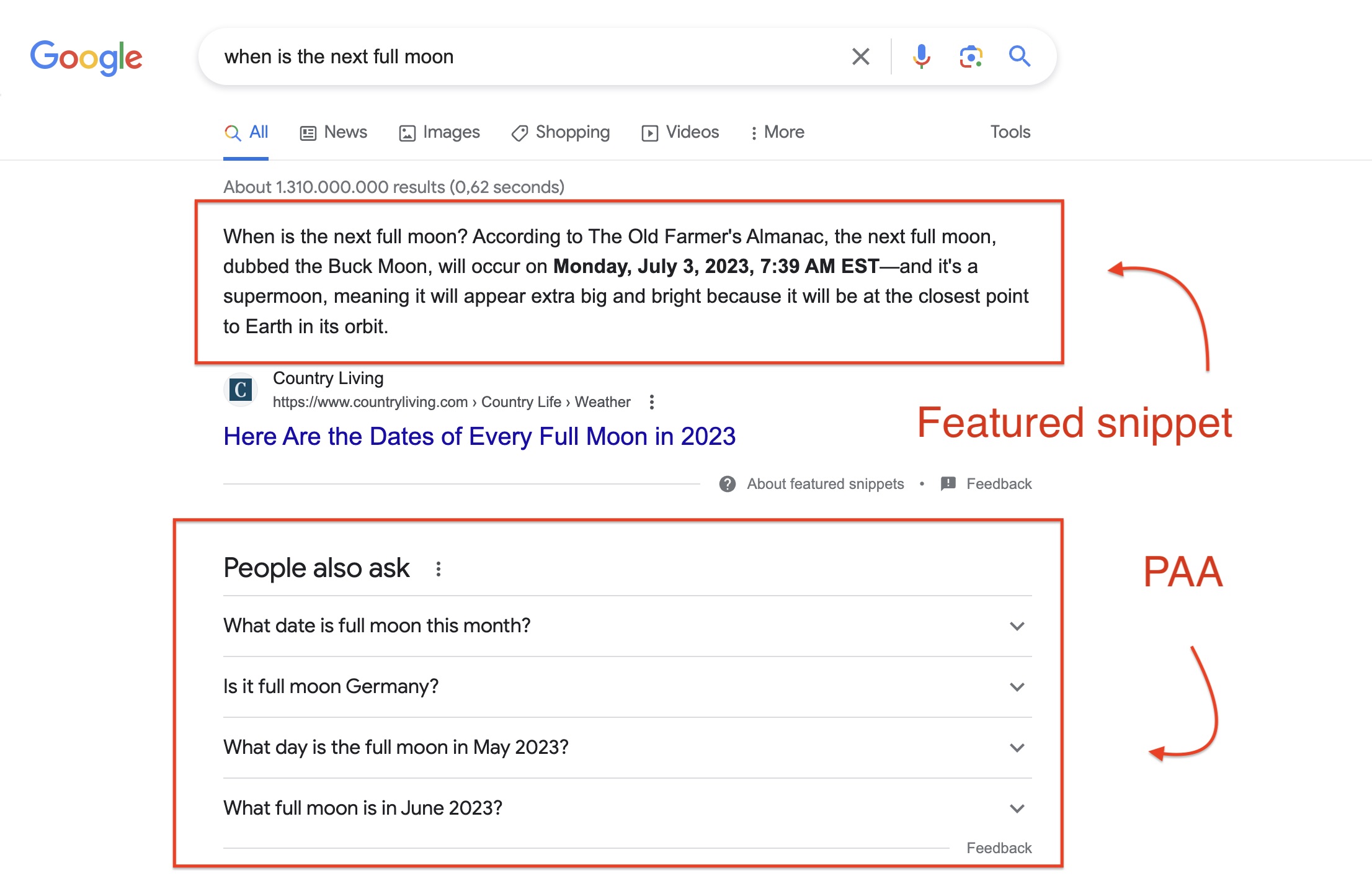
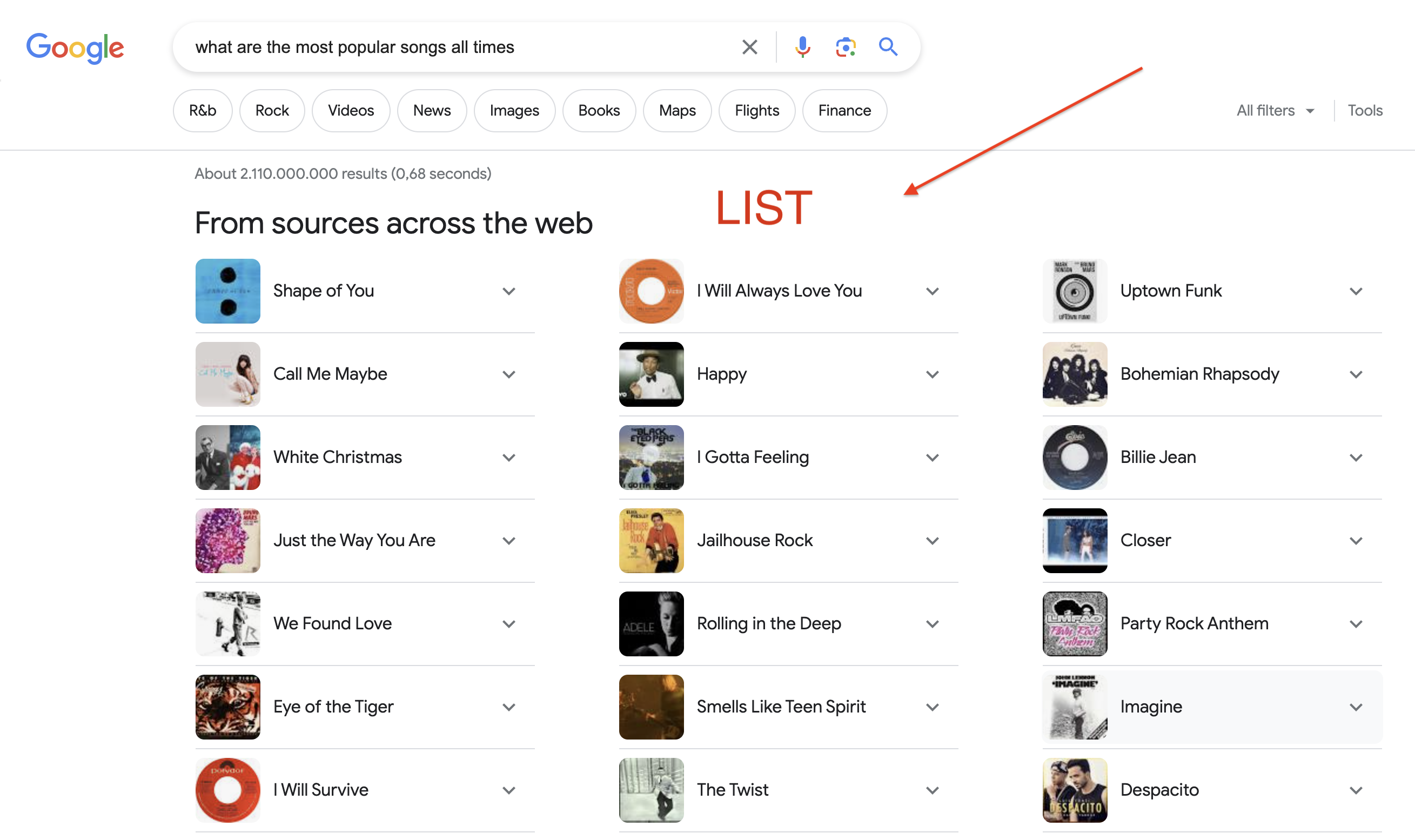
The idea was to make the users satisfied and comfortable, so they don’t have to navigate the external content. After all, Google is a website wanting to maintain the number one place among its competitors, so it will indulge its user’s wishes.
Statistics: 2/3rds of all Google searches are zero-click or only 25%?
At this point, we would like to present you with statistics that changed the face of Google and affected the majority of SEO strategies regarding zero-click content.
Research conducted during the year 2020 – from January to December, showcased that 64% of Google searches end up without users clicking on a link.
It is believed, as the author of the mentioned text applied, that actually, 2/3rds of all Google searches are zero-click searches. Which is quite a number.
Now, the SemRush study on this particular subject presents different numbers. It says 25,6% off the desktop, and 17,3% of mobile searches are zero-click. According to SemRush, the number is not as high as the previous source says, but either way, it’s still significant, especially if you combine two results.
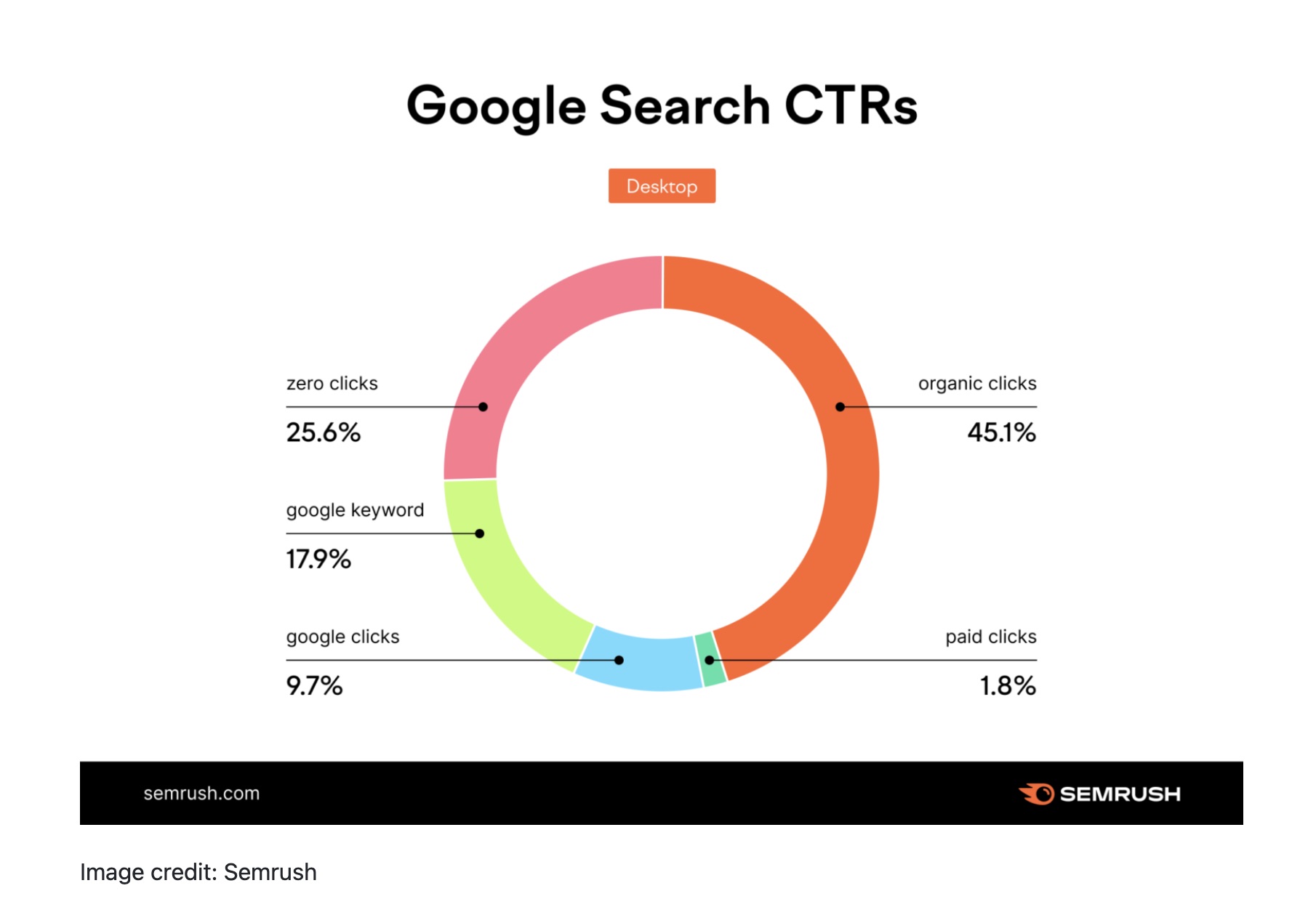
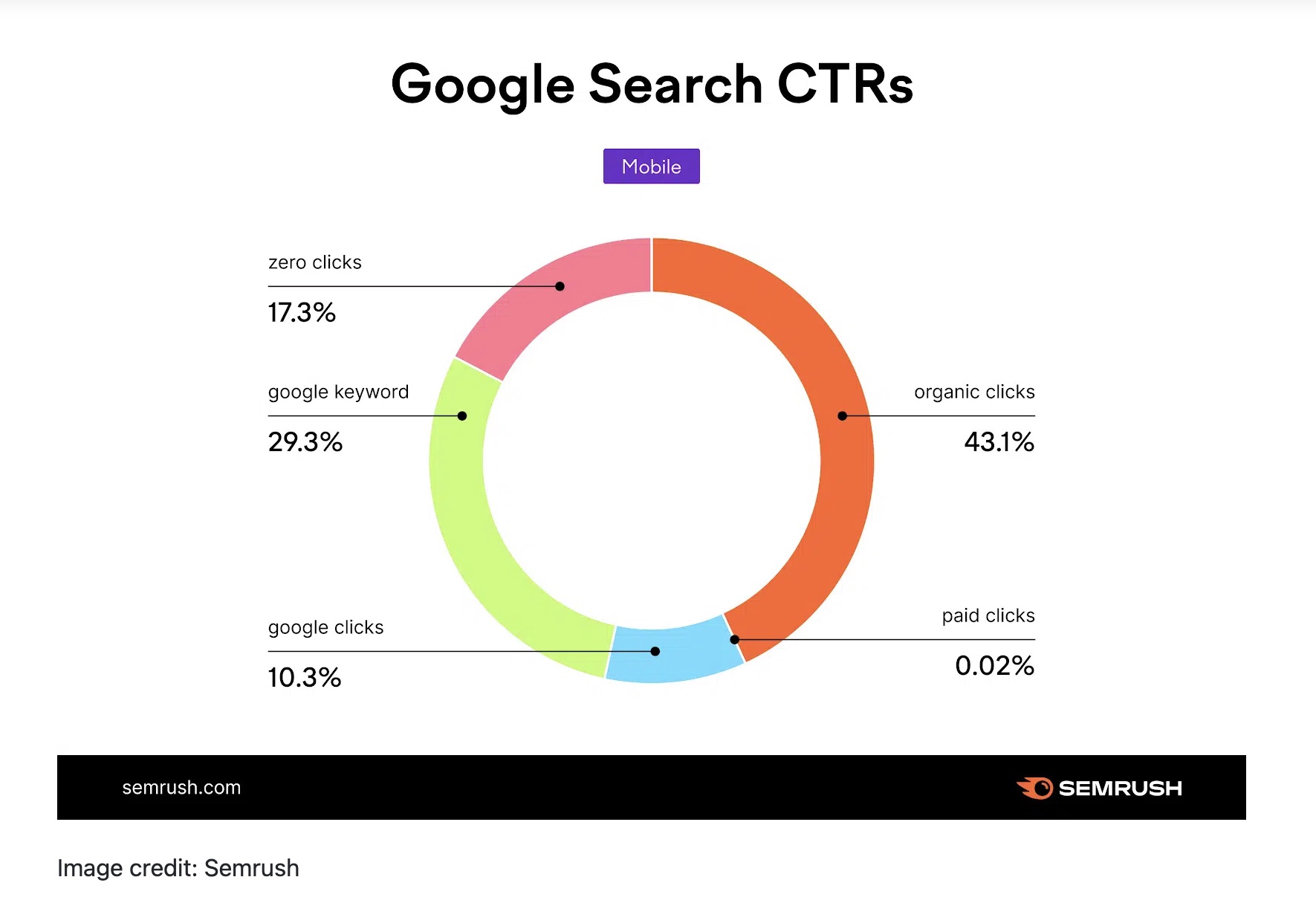
What does this mean for your SEO strategy?
It is time to discuss the most important issue.
The main goal of every SEO strategy is to place your content higher on Google’s SERP – preferably on the top of its first page.
But how is that even possible when the majority of the first SERP is covered with zero-click results Google presented for its users? Did Google become an enemy?
No, Google is just trying to give its users what they want, and you need to adapt to new circumstances.
How?
This is where opinions are divided.
One side argues that you should simply continue encouraging clicks and building your site’s authority as nothing is changed, while others claim you should try becoming a source of information Google is using when presenting the zero-click content.
What’s tricky is that even if your content is ranking as number 1 on Google, it may happen that Google users never see it on the first page because the zero-click content is all over the SERP.
“From a publisher’s side, zero-click searches mean no traffic or earnings. I’m not a fan, but it is what it is. In the end, in many cases, it’s a better user experience; therefore, it makes sense”,
said Servando Silva, affiliate, SEO expert, and owner of servandosilva.com, and added:
“However, the number of zero-click searches has been growing every year, and with the introduction of Google SGE and the generative AI, many informational and transactional searches will slowly become “zero-click,” and we don’t know how much this will affect traffic overall.”
Naveed Shah, owner of the YouTube tech channel, confirms that zero-click searches can impact our SEO strategies in a few ways:
“When users find answers directly on the search page, they are less likely to click on individual websites. This can lead to lower organic traffic and reduced visibility for websites that rely on clicks for user engagement and conversions. Also, with the shift towards zero-click searches, it’s essential to diversify SEO strategies beyond traditional organic search rankings. Incorporating other channels like video optimization, social media marketing, and creating a strong online presence can help reach users even without website clicks.”
Important note: Mobile users are the ones who are usually looking for short and specific answers presented as zero-click content. While desktop and laptop users will click on organic results looking for more thorough information, as well as on paid results. In fact, clicks on the paid results are on the rise at the moment.
Now, if you want to improve your SEO and adapt it to new ways Google algorithm works, this is what you can do:
Tip #1: Optimize content for Google’s features
The way to improve the visibility of your website, as well as its ranking, is by shaping its content in a very exact way – so it suits Google’s features.
One of the methods to do it is to focus on getting your content in Featured snippets. And to achieve that your content needs to be extremely relevant to the query, and written in a precise and super clear manner.
“To improve visibility in zero-click searches, it’s crucial to create high-quality content that directly answers users’ questions. Structuring content with headings, bullet points, and clear information can increase the chances of appearing as a featured snippet. Understanding user intent and providing comprehensive answers can help drive traffic and engagement”,
explains Naveed Shah.
For every query you think of, check if there is a featured snippet and try figuring out why Google took that particular content and presented it on the top of the SERP. There are even tools that are showing which of your keywords are ranking for Google’s featured snippets.
Even if you are writing on a complex subject that cannot be easily summarized and placed into a snippet, you can add some attractive and common questions as headings. That way, you will increase the chances your article shows up as a zero-click result.
It’s the same with the knowledge panel, PAA, and all other features this search engine uses for zero-click searches. With People also ask or People also search for, you can research manually, but you can use Ahrefs and some other SEO tools to see which questions are suggested.
You can always beat the source Google is using as a reference by finding a way to answer the specific query in a better way.
Tip #2: Work on keyword research
Step out of the box and don’t focus only on keyword search volume. Rather check monthly search visits for each keyword you think would be worth investing in.
The thing is, some keywords do have extremely high volume, but never lead to click because the answer is always presented on the top of SERP via featured snippets, for instance.
If there is a huge difference between the keyword’s volume and the number of site visits, you should probably move on to another one. You really want to focus on keywords that are more likely to make Google users click on a link.
Also, focus on long-tail keywords and long-tail searches because it will be more challenging for Google to provide zero-click answers to them.
Tip #3 Emphasize long-form content
If your focus is not on getting Google to reference your content in a snippet, list, or knowledge graph, this is how you can fight for your place on SERP – by offering interesting, relevant, and extensive long-form content.
So quite the opposite of what we were encouraging you to do within tip #1.
If you are covering one topic, we encourage you to do it in a comprehensive way and not skip any important aspect of the theme. Make sure you are covering everything your reader wants to learn on the subject.
With these texts, it’s almost impossible to summarize the theme in two or three sentences, which increases the possibility for the reader to click on your website’s link.
Also, if the content is highly engaging, your audience will go all the way to the end of the piece, increasing the average reading time, which will improve the overall SEO ranking.
Naveed Shah presents another reason why we should all be focusing on long-tail keywords:
“With the rise of voice assistants, zero-click searches have become more prevalent. People often ask questions using voice commands, and the devices read out the answers, skipping the need for website clicks. To adapt, SEO strategies should focus on optimizing for voice search by targeting long-tail, conversational queries and providing clear, concise answers.”
A couple more pieces of advice
- Optimize your existing content for keywords that may show up in Google features
- Incorporate exact questions and answers in your content
- Pay attention to the meta title and meta description
- Use structured data to attract more relevant traffic to your website
- Study the existing zero-click content
“We try to avoid any keywords that can be answered in a sentence or two, or where Google clearly favors rich snippets with low CTRs. I don’t think there’s much to do about it, but you can work on your titles and meta description to increase the CTR of your URLs below the rich snippets and retain some of that traffic. Besides that, you still want to be on page one and possibly the top 3 results to get your piece of the pie,”
Servando Silva elaborates on his approach to zero-click, and added:
“Leverage your site’s favicon, as Google now includes that on top of every URL, and use the characters on the title to showcase other stuff (adding numbers, stats, or a question with good copy can increase your CTR). Also, don’t forget to diversify into other channels, including email, SMS, social networks, etc. Don’t keep all of your eggs in one basket”.
Naveed Shah is offering the following tips:
“Enhance Your Local SEO: Zero-click searches often prioritize local results, such as map listings and knowledge panels. Optimize your online presence for local SEO by ensuring consistent business information (name, address, phone number) across platforms. Encourage positive reviews and engage with local directories to increase visibility for local searches.
Invest in Visual and Video Content: Visual and video content often stand out in crowded search results and social media feeds. Create visually appealing and shareable content, such as infographics, images, and videos, to capture users’ attention. Optimize these assets with relevant keywords and share them across various platforms to expand your reach.
Create Compelling Meta Descriptions: Craft compelling and informative meta descriptions for your web pages. While meta descriptions may not directly impact rankings, they can influence users’ decisions to click through to your website. Make them enticing and relevant to encourage click-throughs.”
As a conclusion
Let’s recap some of the most important aspects of the theme in order to help you improve your ratings and to adapt your SEO tactics.
Yes, zero-click content is affecting your click-through rates (CTRs), and it seems this parameter should not be the only one you focus on anymore.
And it’s super hard to get your audience to engage and answer your CTA call.
But most importantly, keyword targeting for zero-click content is completely different than the traditional one. It makes no sense to target the strongest keywords that already have been answered on the top of the first SERP.
So does zero-click content impact your SEO? Yes. Your monetization plan? Absolutely.
It’s a new reality, and it’s on you to adapt – “If you can’t beat them, join them”.
Optimize your content to be recognized by Google’s zero-click content features, or fight the Google and zero-click principle by creating valuable and extended content.
Which suggestion do you prefer? Tell us your thoughts on this burning topic in the comment section below.
